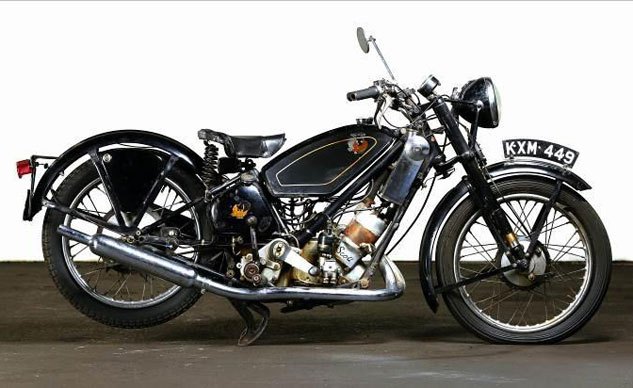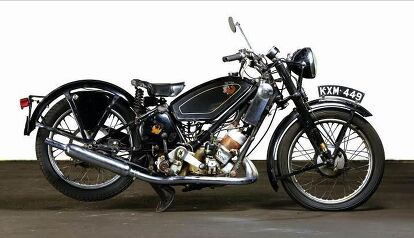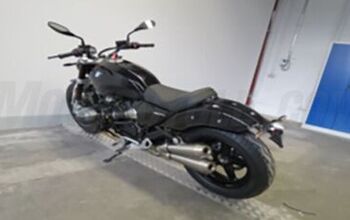Throwback: 1939 Scott Flying Squirrel
Liquid-cooled two-stroke sportbike from before WW2
Below is the first in a four-part series highlighting rare and historic motorcycles. Today’s subject: the 1939 Scott Flying Squirrel. Penned by Motorcycle.com contributor Paul Garson, this series will examine the backstory of four of the world’s most collectible motorcycles, what made each so special and why they are so highly sought after today.
“Unconventional excellence” sums up the British-built Scott Flying Squirrel, and that goes far beyond its odd choice of name. Designed by two-stroke pioneer Alfred Angus Scott, the lightweight machines with their low center of gravity scored many records. Scott, an engineer, artist, and musician, is considered one of the most brilliant innovators in the history of motorcycling. He was a big fan of the two-stroke design and came up with a parallel-Twin version in 1901. By 1908 he had obtained the definitive patent, a liquid-cooled two-stroke Twin fitted into a triangulated frame.
In 1912 the Scott rocked the motorcycle world when it became not only the smallest machine to enter, but the first two-stroke ever to win the Isle of Man Tourist Trophy event, averaging 48.7 mph. While four-stroke competitors whined and complained the “bloody fast” bikes were “too good” and thus not sporting, Scott repeated its historic victory at the 1913 TT. Sales soared as a result, prompting the building of a new factory at Shipley, Yorkshire, the small industrial town located in north central England. The name Shipley now appeared on the tank logo.
Scott left the motorcycle company in 1915 to pursue his interest in hybrid car/motorcycle designs. Scott, who amassed some 50 engineering patents, was also an ardent cave explorer. After one spelunking adventure, while driving home wearing wet clothing in an open 3-wheel car of his design, he caught pneumonia and passed away. The date was July, 1923. But his unique design lived on at The Scott Motorcycle Company, which had introduced the Squirrel in 1922.
With its optional full-frame gas tank, a nod to the works racers of the day, the Super Squirrel was launched at the 1925 Olympia Show, followed in 1926 by the Flying Squirrel. Subsequent improvements included the addition of a duplex frame, bigger brakes, and magneto power. By the 1930s, the Flying Squirrel took on more of a touring role, being further updated with detachable cylinder head, Brampton forks and a foot-change gearbox. Efforts were made to develop three-cylinder models but they came to naught.
Production ceased during WWII and did not resume until 1946 with the relaunching of the Flying Squirrel. However, only a few years later, in 1950, the company ran aground financially. By 1956 there was renewed hope when Matt Holder bought the Scott rights. He added a new plunger rear suspension, twin front brakes and telescopic forks to the original design. However, the committed effort to revive the Scott brand faded away in the late 1960s.
Now enter another Scott fan, George Silk, with a plan to place the Scott powerplant into a “modern” frame. The year was 1970 and the Scott saw its first update in some 40 years. With partner Maurice Patey, they began producing limited numbers of Spondon-frame Silks, the 660cc twins now pumping out 48 bhp and able to travel 100-plus mph. A sport-tourer and production racer were offered from 1971-75 … a total of 21 machines were produced. Then in 1975, George announced the all-new Silk 700S, using a 180-degree, 653cc parallel-Twin sloped at 40 degrees and producing 45 bhp. While more expensive than the 53 bhp 1975 Norton 850cc Commando, it was 100 pounds lighter, tipping the scales at only 305 lb. It scored high marks for performance (115 mph) and handling. However, by 1979 only 138 had seen the light of day before the company folded; today they are rare and much sought after machines.
All said and done, the original Scott machines as seen here found a fan base happy with their controversial nature. The bikes were popular when new and still enjoy a strong cult following. With its distinctive “yowl/growl” the Flying Squirrel is considered one of the great machines of motorcycling history. This particular bike shows only 2,964 miles on the odometer. Producing 26 hp and ratcheting through a 3-speed tranny, the 309-pound machine could fly to 80 mph – faster than any squirrel I know.
More by Paul Garson







































Comments
Join the conversation
How nice to see the Scott Flying Squirrel reviewed.
I owned one in the late 1940s. Great performance and what a sound when in "full song"
Mine kept siezing up due to the wrong brand of piston having been fitted after a re-bore. The cure was to cut DOWN the oil flow which had a drip feed sight glass, and to run on a petrol and oil mix.
by jiggling the spark control the engine could run backwards, but it was not recommended..
I look forward to further old classics articles.
I am presently riding an 06 Vulcan 750 and enjoying it.
Hey Rocky! Watch me pull a motorcycle out of my hat!